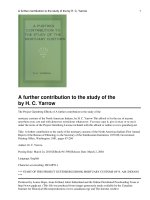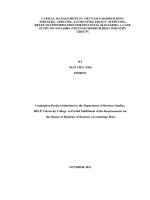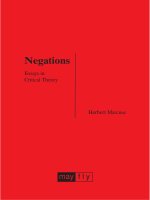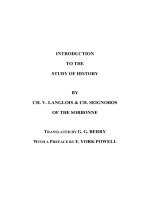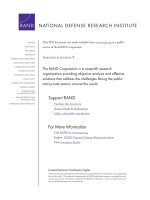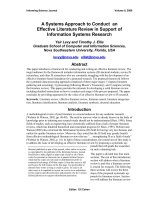covers the literature review in the theory background moreover, this chapter represents relevant information for understanding the study mor
Bạn đang xem bản rút gọn của tài liệu. Xem và tải ngay bản đầy đủ của tài liệu tại đây (301.46 KB, 57 trang )
ABSTRACT
This study aims at improving writing English enquiry letters and reply to enquiry
letters in business correspondence for sale staffs of Poong Shin Vina Ltd Company.
The writer try to analyze how English enquiry letters and reply to enquiry letters to be
written by sale staffs, to be more specific what are common mistakes are being made
by sale staffs at the company. The result indicates that all staffs in Sale Department
still have trouble in writing English these letters. There are still many errors in content,
lexis and grammar when staffs writing. The study arrives at a conclusion that sale
staffs should be improve about writing English letters background by reading materials
in Internet and Academic book.
1
1
ACKNOWLEDGMENT
First of all, I would like to express my deep gratitude to all the lecturers at
English Department- Thuong Mai University for their valuable lessons which laid the
foundation for my thesis.
I would like to show my deep gratitude to Mrs Vu Thi Thu Trang- the supervisor
who has been giving guidance, materials and invaluable suggestion for me to complete
the study timely. Thanks for her ever-enthusiasm, responsibility and devotion.
On this occasion, I wish to express my very sincere thanks to all sale staffs in
Poong Shin Vina Ltd Company for their co-operation and support my data collection,
providing me with insights into writing English enquiry letters and reply to enquiry
letters.
At last, I would like to extend my many thanks to my family and my friends for
their constant assistance and encouragement during the time I carry out the study.
Ha Noi, 22 April 2018
Tran Thi Ngoc
2
2
TABLE OF CONTENTS
3
3
LIST OF ABBREVIATIONS
pp
C.I.F
pages
Cost, Insurance, Freight
e.g
MA
PhD
For example
Master of Arts
Doctor of physolophy
4
4
số trang
Tiền hàng, Bảo hiểm, Cước
phí
ví dụ
thạc sĩ văn chương
tiến sĩ
LIST OF TABLES AND FIGURES
List of figures
5
5
CHAPTER 1. INTRODUCTION
1.1.
Rationale
The rapid development of the global economy leads more and more the large and
small international trade cooperation and business negotiation happened. As the result
of this, the economic with no barriers can not be avoided in all country. After joining
the World Trade Organization, Vietnam's economic status was enhanced. With the
acceleration of world economic integration and rapid development of international
trade, business correspondence is an important tool for trade transaction. With the
globalization of the economy, the strengthening of international trade cooperation,
business correspondence for individual companies is dispensable to pass along all the
necessary detailed information. Business correspondence is a great solution for the
development of supply and demand side of the drawbacks of asymmetric information,
making all the information timely and effective delivery in every corner of the world,
in various countries and in numerous companies.
Poongshin Vina Ltd is the foreign joint venture company, has co-operation with
other foreign enterprises to exchange goods, so business correspondence is essential
and every employees must be have a business correspondence writing skill, especially
writing enquiry letters and reply to enquiry letters.
But there is fact that not all employees in company are able to write an English
letters successfully due to the limitation of knowlegde. Write a good letter means the
staffs use a special language in appropriate format and clear content to persuade the
receivers and make a good impression to them.
Writing a good English business letter is not really easy. There are many types of
business correspondence and almost staffs do not know how to write it correctly.
People sometimes make mistake in their letters without being aware about it, which
becomes a common problem to employees in Poong Shin Vina Ltd.
Realizing the problem, I decided to carry out “the study on improving writing
English enquiry letters and reply to enquiry letters in business correspondence for sale
staffs of Poong Shin Vina Ltd Company” to help people deeply understand about these
types of letter with the hope that they can write an English business letter better.
6
1.2.
Previous studies
Nowaday, writing an English enquiry letters and rely to enquiry letters is so
important for all company, especially companies have foreign partners, so reseaching
how to write these letter successfully is essential. In fact, many people have studied
and written about this area, such as:
Kenneth Beare ( 1975) he wrote a study about “learn to write an enquiry
response business letter”. In the paper, he mentioned some aspects of the enquiry
response business letter: definition, important language to remember when you write a
rely to enquiry letter and he also gave example letter. His study was updated in
ThoughtCo.- the world’s largest education resouse because all information was given
quite sufficient and exactly. However, he didn’t mention about the function and parts
of the enquiry response business letter.
In Business Correspondence ( 1956) of J Thomas, University of Michigan, he
wrote about the definition and the way to write an enquiry letter but did not mention
about the reason why we write it, what’s the section of this letter and give the example
about it.
“The importance of writing English enquiry letters and reply to enquiry letters”
(2004)- Khaled Alshare and Nihan Hindi explored the role of enquiry letters and reply
to enquiry letters for business staffs. The results of the study showed that forty-five
percent of informants indicated business staffs were required to writing English
enquiry letters and reply to enquiry letters for working. Staffs and instructors agreed
that critical objectives of writing English enquiry letters and reply to enquiry letters
need to be improved.
So, in my study, I will carry out a study about both enquiry letter and reply to
enquiry letter with the most complete information include definition, the function, the
reason to write, the parts and example of these letters. Moreover, I will give the things
to keep in mind when writing.
1.3.
Aims of the study
The aims of the study is to help all sale staffs in PoongShin Vina Ltd Company
become more professional when writing English enquiry letters and reply to enquiry
letters. It includes the following objectives:
7
-
Giving literature review of definition, writing process and functions of letters
Providing the basic and essential knowledge about the format, style language used in
-
enquiry letter and reply to enquiry letter.
Finding out some common errors in writing English enquiry letter and reply to enquiry
letter to help people in the company avoid making those mistakes and have a good
1.4.
-
skill in writing English letters.
Research subjects
There are many types of business correspondence such as:
Business Enquiry Letter
Quotation Letter ( reply to enquiry)
Order Letter
Complaint Letter
Recovery Letter
However, the researcher can study on enquiry letter and reply to enquiry letter
because of the limitation of time and knowledge and these letters are commonly used
by sale staffs in PoongShin Vina Ltd Company.
A survey with twelve sale staffs in Sale Department has been conducted. The
researcher choose all sale staffs as participants because they often take responsible in
writing business letters and they always connect company with other important
partners. Besides, the reseacher would like to see what common mistakes when they
writing English enquiry letters and reply to enquiry letters and the difficulty that they
face.
8
Scope of the study
This study will focus on writing English enquiry letter and reply to enquiry of all
1.5.
sale staff in Poong Shin Vina Ltd Company who are responsible for dealing with
foreign partners.
Reseach methodology
To finish this graduation paper, I search and collect primary data from different
1.6.
reference books related to writing English enquiry and reply to enquiry and from the
websites on the internet.
Besides, questionaire and interviews have been used as the main sources for data
collection. Firstly, by using questionaires the researcher can obtain data quantitively,
which later on will assist the study with persuasive figures concerning the investigated
issues. And by using interviews, the researcher could have more in-depth information.
Before the interview, the researcher had prepared a set of questions. Additionally,
some possible follow-up questiones were also prepared ( for the interview questions,
1.
2.
3.
4.
5.
1.7.
refer to appendices)
The steps of the study were as follows:
Piloting the questionaires for sale staffs
Delivering and gathering back the questionaires
Conducting interviews with the selected sale staffs
Analyzing the collected data and dicussing the findings
Giving suggestions.
Organization of the study
Apart from acknowledgement, table of content,conclusion, reference and
appendix, this study includes four main chapter: Overview of the study, Literature
-
review, Reseach findings and Recommendations and suggestion:
Chapter One: introduces the problem, gives an overview about the study and describes
the needs of writing English enquiry letter and reply to enquiry letter in business. This
chapter also discusses the rationale, previous studies, the aims of the study, research
subjects, the scope of the study, research methodology and organization of the study.
-
Chapter Two: covers the literature review in the theory background. Moreover, this
chapter represents relevant information for understanding the study more.
-
Chapter Three: analysis of written by some information about subject, data collection
-
instruments and procedures
Chapter Four: gives some suggestions to improve the writing English enquiry letter
and reply to enquiry letter for sale staffs of Poong Shin Vina.
.
9
10
CHAPTER 2. LITERATURE REVIEW
2.1. Overview on writing
2.1.1. Definition of writing
Writing has been with us for several thousand years and nowaday it becomes
more important than ever. It is a skill that people in all parts of life use every day. A
teacher, for example, has to write lectures, a chief accountant has to write reports to
general director every month. As a student, I have a pile of writing tasks: essays,
assignments, internship report, graduation study, etc. So, in order to give the answer to
the question “What is writing”, many people say that they know what writing is but
they cannot find the right words to define it. Meanwhile, there are a lot of authors
giving the definitions of writing on their own viewpoints as follows:
-
Writing is a set of visible or tactile signs used to represent units of language in a
systematic way, with the purpose of recording messages which can be retrieved by
everyone who knows the language in question and the rules by virtue of which its units
are encoded in the writing system
(Daniels, Peter T. & Bright, William, The world's writing systems, P.3 (Oxford,
-
Oxford University Press, 1996)
Writing is a system of more or less permanent marks used to represent an utterance in
such a way that it can be recovered more or less exactly without the intervention of the
utterer
(Daniels, Peter T. & Bright, William, The world's writing systems, P.3 (Oxford,
Oxford University Press, 1996)
In short, different authors define the term writing in different ways. It’s about
discovering ideas, thinking about how to communicate and develop them into
statements and paragraphs that will be comprehendible to a reader. Besides, writing
has dual purpose- to express and impress. Writers must select the most advantageous
medium for their writing and each types has a different level of difficulty which
determined by its objectives.
2.1.2. Types of writing
Whether the writer write essays, business materials, fiction, articles, letters, or
even just notes in their journal, their writing will be at its best if you stay focused on
11
their purpose. While there are many reasons why the writer might be putting pen to
paper or tapping away on the keyboard, there are really only “four main types of
writing: expository,
descriptive,
persuasive, and narrative”
(Catherine
Traffis-
Grammarly blog). Each of these four writing genres has a distinct aim, and they all
require different types of writing skills.
Expository Writing
The word expository contains the word expose, so the reason expository is an apt
descriptor for this type of writing is that it exposes, or sets forth, facts. It is probably
the most common writing genre the writer will come across throughout their day. In an
expository piece, a topic will be introduced and laid out in a logical order without
reference to the author’s personal opinions. It begins with a sentence that gives a point
of view on a topic, lists the arguments giving reasons and evidence for them uses
convincing language eg ‘will damage’ instead of ‘may damage’.
Example:
The municipal government of Happyville unanimously approved the construction
of sixty-two miles of bike trails in 2017. Made possible by a new tax levy, the bike
trails are expected to help the city reach its sustainability and clean air goals while
reducing traffic and congestion. Eighteen trailheads with restrooms and picnic areas
have been planned at a variety of access points. The city expects construction to be
complete in April 2021.
This paragraph is expository because it supplies the reader with facts and figures
about its topic, the new bike trails, without offering the author’s opinion on it.
Descriptive Writing
The aim of descriptive writing is to help the reader visualize, in detail, a
character, event, place, or all of these things at once. The author might describe the
scene in terms of all five senses. Descriptive writing allows the writer a great deal
more artistic freedom than expository writing does.
Example:
12
The children pedaled leisurely down the Happyville Bike Trail, their giggles and
whoops reverberating through the warm spring air. Sweet-scented wildflowers brought
an array of color to the gently undulating landscape, tempting the children to
dismount now and then so they could lay down in the springy, soft grass.
This passage paints a vivid picture of a scene on the new bike trail.
Persuasive Writing
The aim of persuasive writing, or argumentation, is to influence the reader to
assume the author’s point of view. The author will express personal opinions in the
piece and arm him- or herself with evidence so that the reader will agree with him or
her.
Example:
The bike trail is the glittering gem of Happyville’s new infrastructure. It winds
through sixty-two miles of lush landscape, dotted by clean and convenient facilities. If
you haven’t experienced the Happyville Bike Trail yet, ditch your car and head
outside! Could life in Happyville get any more idyllic?
A number of statements in this paragraph are opinion rather than fact: that the
bike trail is a glittering gem, that the facilities are clean and convenient, and that life in
Happyville is idyllic. Clearly, the author’s aim here is to use these depictions to
persuade readers to use the bike trail.
Narrative Writing
The purpose of narrative writing is to tell a story, whether that story is real or
imaginary. Pieces in a narrative style will have characters, and through the narrative,
the reader learns what happens to them. Narrative writing can also include dialogue.
Example:
As I cycled down the trail, I heard children giggling and whooping just around
the bend. I crested a small hill and coasted down the curving path until I found the
13
source of the noise. Three little girls sat in the grass by a big oak tree. They were
startled to see me, and I smiled kindly to put them at ease.
“Whatcha doing?” I asked.
“Nothing,” they chirped in unison.
In this passage, the author sets the scene on the bike trail from his or her own
point of view (which is referred to as narrating in the first person). Using both
description and dialogue, the story that takes place is laid out in chronological order.
2.1.3. Process writing
Writing is one of the most common ways we communicate. Base on lesson of
Katie Surbe ( chapter 11/ lesson 8), to be a successful writer, the writer should practice
the five steps of the writing process: prewriting, drafting, revising, editing, and
publication.
Prewriting
The first step of the writing process is prewriting or our planning stage. During
prewriting, the writer are thinking about their topic, brainstorming, focusing, and
developing a working thesis.
This step begins with the assignment, writer first spends time asking themself
questions about the topic, such as: 'What do I want to write about?', 'What do I hope to
achieve?', 'What personal views do I have?', or 'What do I want my audience to learn?'.
The next step is to brainstorm some potential topics. There are many different
ways to brainstorm, but some the writer could use would be make a list, journal write,
or create a chart.
Finally, the writer need to make sure that their topic is focused and write down a
working thesis, the central idea of their paper. One great way to make sure a topic is
focused is to develop a rough outline. This does not have to be formal but, rather, the
writer should write down the thesis and the main ideas that the essay will explore.
Drafting
It is important to remember that a draft does not have to be perfect! The goal of
the drafting stage is to take their outline and to develop a paper. When the writer draft,
do not worry about the mechanics of their paper, this will come later. Right now, they
should focus on the content and make sure that their ideas are clear and well detailed.
14
When writing the paper, the writer should ask themself some questions that they
too can use:
'Are my ideas organized?'
'Am I sharing strong details?'
'Should I include more information or take some away?'
As the authors write, be sure to keep asking themself questions that will help
further develop and support their thesis.
The writer should write more than one draft! Often times, they will write several
before they begin the next step of the writing process.
Revising
With this step, the writer should read their writing and look at the content. They
can think of revising as looking at the big picture. They should do not worry about the
mechanics of their paper, but focus on the content.
Before starting the revising and editing stages, it is important to set the right
environment! Here are some tips:
The writer should try to take some time away from their paper. Set it aside for a
few hours or even days. This way they are starting with fresh eyes.
Print out their paper. This way the writer can take notes as they revise and edit.
The writer could even change the format of their paper! It could be a larger,
bolder font, which may help they find the errors in their writing.
Work somewhere without distractions. Turn off the phone and TV. Just focus on
their writing!
Editing
The writer have overhauled their story. It’s time to fine tune their manuscript line
by line. Check for repetition, clarity, grammar, spelling and punctuation. Editing is an
extremely detailed process and is really best done by a professional. Nobody wants to
read a book that is full of mistakes.
Publishing
This stage involves sharing the writing with an intended audience and may
involve preparing a neatly handwritten or word processed copy of the final draft and
15
the addition of illustrations or other graphic elements. Publication may extend to a
multimedia presentation or lead to a public performance.
2.1.4. Common errors in writing
Error is the state or condition of being wrong in conduct or judgement
(en.oxforddictionaries.com)
Error is something have done which is considered to be incorrect or wrong or which
should not have been done
(www.collinsdictionary.com)
2.1.4.1. Lexical errors
2.1.4.1.1. Definition of lexis
Lexis has been defined in many different ways. Here are some main definitions
of lexis:
According to Richard ( Lexical errors in second language scientific writing (1992)/
40), lexis is “ a set of lexemes, including single words, compound words and idioms”
Another definition was given by Penny Ur ( Lexis in the series market leader
(1996)/43), lexis could be understood as all the words taught in the foreign language.
Moreover, from his point of view, lexis “may be more than a single word”.
And in Oxford Dictionary, definition of lexis in English is “the total stocks of words in
a language”
2.1.4.1.2. Lexical error classification:
Wrong word form: refers to words mistakenly selected
Misformation: refers to words that don’t exist in the target language, which either are
the results influenced by the mother tongue or are coined by the learners from the
sources of the target language.
Distortion: refers to forms non-existent in the target language, which results from
misapplication of one or more of the processing operations
Confusion of sense relations : a word being used in contexts where a similar word
should be used
Errors in slang, idioms, collocation and colloquial
2.1.4.2. Grammatical errors
2.1.4.2.1. Definition of grammar
Grammar is the set of structural rules that governs the composition of clauses, phrases
and words in any given natural language. The term refers also to the study of such
16
rules and this field includes morphology, syntax, and phonology, often complemented
by phonetics, semantics and pragmatics
( David Crystal, “In Word and Deed” (2004)/13)
Grammar is the whole system and structure of a language or of languages in general,
usually taken as consisting of syntax and morphology (including inflections) and
sometimes also phonology and semantics
( John Dryden, “ Art of Grammar” (1964)/254)
2.1.4.2.2. Grammatical error classification
Here are some main grammatical errors in writing that writers make:
Subject- verb agreement
Subject omission
Word order
Auxiliary verb
Preposition
Conjunction
Run on sentences
2.2. Overviewing on business correspondence
2.2.1. Definition
Base
on
Business
Correspondence
Book
by
Anonyous,
“Business
Correspondence is an umbrella term for all written communication used in business
relationships with business partners or for internal communication in the organization.
The business correspondence includes all written correspondence in organizations
such as personal documents, simple legal documents, personal letters, business
contracts, marketing materials and official letters, both in electronic and paper form.”
2.2.2. Importance of business correspondence
Nowaday business operations are not restricted to any locality, state or nation.
Today production takes place in one area but consumption takes place everywhere.
Since the businessmen as well as customers live in far off places they don’t have
sufficient time to contact each other personally. Thus, there arises the need for writing
letters. In the past the situation was not so. Business letters were not essential in olden
days. But now the importance of letters has increased because of vast expansion of
business, increase in demand as well as supply of goods.
17
There are many viewpoints about importance of business correspondence.
According to Claire Whitmell( Business Writing Essential/ 167), here are roles of
business correspondence:
-
Help in maintaining proper relationship: Nowaday business activities are not confined
to any one area or locality. The businessmen as well as customers are scattered
throughout the country. Thus, there is a need to maintain proper relationship among
them by using appropriate means of communication. The customers can write letters to
the businessman seeking information about products and businessmen also supply
various information to customers. This helps them to carry on business on national and
-
international basis.
Create and maintain goodwill : Sometimes business letters are written to create and
enhance goodwill. Businessmen at times send letters to enquire about complaints and
suggestions of their customers. They also send letters to inform the customers about
the availability of a new product, clearance sale etc. All this results in cordial relations
-
with the customers, which enhances the goodwill of the business.
Help in expansion of business: Business requires information regarding competing
products, prevailing prices, promotion, market activities, etc. If the trader has to run
from place to place to get information, he will end up doing nothing. It will simply
result in loss of time. But through business letters, he can make all enquiries about the
products and the markets. He can also receive orders from different countries and, thus
enhance sales
2.2.3. Parts of a business correspondence
The essential parts of a business letter should be included as Business
Correspondence Book/English Department- Thuong Mai University/7):
1. Heading: usually contains the name and postal address of the business, E-mail address,
Web-site address, Telephone Number, Fax Number, Trade Mark or logo of the business
(if any)
2. Date: The date is normally written on the right hand side corner after the heading as
the day, month and years.
3. Reference: It indicates letter number and the department from where the letter is being
sent and the year. It helps in future reference. This reference number is given on the
left hand corner after the heading
18
4. Inside address: This includes the name and full address of the person or the firm to
whom the letter is to be sent. This is written on the left hand side of the sheet below
the reference number. Letters should be addressed to the responsible head e.g., the
Secretary, the Principal, the Chairman, the Manager etc.
5. Subject: It is a statement in brief, that indicates the matter to which the letter relates. It
attracts the attention of the receiver immediately and helps him to know quickly what
the letter is about.
6. Salutation: This is placed below the inside address. It is usually followed by a comma
(,). Various forms of salutation are:
Sir/Madam: For official and formal correspondence
Dear Sir/Madam: For addressing an individual
Dear Sirs/Dear Madam: For addressing a firm or company
7. Body of the letter: This is the main part of the letter and it contains the actual message
1.
of the sender. It is divided into three parts:
Opening part: It is the introductory part of the letter. In this part, attention of the reader
2.
should be drawn to the previous correspondence(if any)
Main part: This part usually contains the subject matter of the letter. It should be
3.
precise and written in clear words
Concluding Part: It contains a statement the of sender’s intentions, hopes or
expectations concerning the next step to be taken. Further, the sender should always
look forward to getting a positive response. At the end, terms like Thanking you, With
regards, With warm regards may be used.
8. Complimentary close - It is merely a polite way of ending a letter. It must be in
accordance with the salutation. For example:
19
Salutation
Complementary close
Dear Sir/Dear Madam
Dear Mr. Raj
My Dear Akbar
Yours faithfully
Yours sincerely
Yours very sincerely (express very informal
relations)
9. Signature: It is written in ink, immediately below the complimentary close. As far as
possible, the signature should be legible. The name of the writer should be typed
immediately below the signature. The designation is given below the typed name.
Where no letterhead is in use, the name of the company too could be included below
the designation of the writer.
10. Enclosures: This is required when some documents like cheque, draft, bills, receipts,
lists, invoices etc. are attached with the letter. These enclosures are listed one by one in
serial numbers
11. Copy circulation: This is required when copies of the letter are also sent to persons
apart of the addressee. It is denoted as C.C
12. Post script: This is required when the writer wants to add something, which is not
included in the body of the letter. It is expressed as P.S
Example letter:
Tel. 3241053
Fax. 3244155
M/s Acron Electricals
22/c, Main Road
New Delhi Darya Ganj -2
E-mail:
Website:
Ref. PR/F/2002/32
Dated: August 22,2002
M/s Bharat Fans
Bharat Complex
Hyderabad Industrial Estate
Hyderabad - 500032
Subject: Your letter of quotation No. SL/F/2002/12 dated August 10,2002
Dear Sir,
Many thanks for your prompt reply to our enquiry letter of July 27, 2002. As we find
your prices and terms quite reasonable, we wish to place a trial order as per the list
enclosed.
As pointed out in our enquiry letter, quality is important. Should the goods meet our
expectations, substantial orders will follow.
Payment will be made within the time limit prescribed in your quotation letter. Thanking
You,
Yours faithfully,
For M/s Acron Electrical
20
Sd/(A.B.Kumar)
Partner
Encl: Order List
(English Department- Thuong Mai University/ Business Correspondence
Book/165)
2.2.4. Types of business correspondence
a, Business Enquiry Letter
Sometimes prospective buyers want to know the details of the goods which they
want to buy, like quality, quantity, price, mode of delivery and payment, etc. They may
also ask for a sample. The letter written to sellers with one or more of the above
purposes is known as enquiry letter.
b, Quotation Letter ( reply to enquiry)
After receiving the letter of enquiry from a prospective buyer, the sellers supply
the relevant information by writing a letter that is called quotation letter. These letters
are written keeping in view the information asked for like price list, mode of payment,
discount to be allowed etc. Businessman should reply to the inquiries carefully and
promptly.
21
c, Order Letter
The prospective buyer after receiving the reply to his enquiry letter may decide to
place on order with that business house which offers goods at minimum price and at
favorable terms and conditions. Letters written by a buyer to the seller giving the order
to purchase the goods is called order letter.
d, Complaint Letter
A complaint letter is written when the purchaser does not find the goods up to his
satisfaction. It is normally written by the purchaser when he receives wrong, defective
or damaged goods or receives incorrect quantity of goods. It can also be written
directly to the transit authority when the goods are damaged in transit. Thus, we may
define a letter of complaint as the letter that draws the attention of the supplier or any
other party on account of supply of defective or damaged goods.
e, Recovery Letter
The letter written by the seller for collection of money for the goods supplied to
the buyer is called recovery letter. The aim of recovery letter is to collect money
without annoying the customers. The letter should include information regarding the
amount of arrears argument for payment, and last date for payment. The language of
recovery letter should be polite, so that the customer is not offended and future
transactions with him are not adversely affected.
2.3. Enquiry letter
2.3.1. Definition
A letter of enquiry “is a letter written to request information and/or ascertain its
authenticity. A letter of inquiry deals with various matters like job vacancies, funding,
grants, scholarships, projects, sales, pre-proposals and others” ( Anderson/ study.com).
A letter of enquiry serves to facilitate business operations and satisfaction of the
sender. Enquiry letters remove any misunderstanding and are time savers, especially
when two parties want to reach an understanding. The communication towards this
effect resolves the issue without any delay.
A letter of enquiry may be used in a variety of cases, including when:
22
A job or internship is posted, and the writer would like to express interest and
enquire about the availability of the same or similar opportunity at a future time (next
semester, summer, etc.) that better fits their schedule
A networking contact has recommended an organization, and the writer would
like to inquire about possibilities for an internship with the organization (include his or
her name as a reference)
2.3.2. Types of enquiry letter
According to Scribd ( Professional writing letter/ 3), there are 2 kinds of enquiry
letter depending on the main purpose:
a, Personal status enquiry letter
This kind of letter is written by employers in order to know more about the
personal details of an applicant in the job search. This kind of letter is used by the
employer in order to get to know more about the skills, abilities and relevant
information about the person as a worker in order to find out if the applicant meets
with the necessities of the job. After this first enquiry letter, applicants tend to send a
response with all information required by the employer plus a little detail about
themselves.
b, Business status enquiry letter
This kind of letter is written when a company or enterprise wants to know more
about another enterprise or company. This is especially used to ask for information
about a customer or a plan or work. However, it can also be used for the purpose of
asking for financial capabilities, assurance, honesty, responsibility and the way of
doing business from one company to another in order to find out if a business
relationship is necessary or can be fruitful.
2.3.3. Functions of enquiry letter
Enquiry letter plays an important role in modern business. Enquiry letter being a
representative to many types of other letters requires an impressive opening. The
following are the major functions of writing this letter:
•
Probable quantity required and the time-frame for the supply of the product / service.
•
Obtaining information about financial capability of prospective customers.
23
•
The seller’s terms on credit, discounts, transit, packaging etc., should be enquired into.
•
Determining the risk of credit sales.
•
Deciding whether to enter into credit transactions.
•
Opening sentences to indicate the reasons for the enquiry.
•
Getting information about honesty, goodwill and business morality of the probable
buyer.
•
Knowing about the relationship of the prospective bum with other business community
and associations.
•
Enhancing sales with various parties by evaluate their financial and business viability.
2.3.4. Format of enquiry letter
1.
•
•
•
•
•
•
2.
•
•
•
•
•
3.
•
•
•
•
•
HEADER:
Organization letter head
Your name
Your address ( should be positioned to the right)
Date ( should be positioned to the right)
Recipient’s name ( specific official or person)
Recipient’s address( can be positioned only to the left)
BODY
Reference or subject ( as require)
Dear recipient ( salutation)
First paragraph ( aligned left)- details of the enquiry
Second paragraph ( aligned left)- brief history, suggestion, statistical data etc.
Third paragraph ( aligned left)- offer assistance towards communication and assistance
CLOSING
Subscription – Thanking you, yours sincerely etc.
Your Signature
Your Typed First Name Last Name
Your Designation (as required)
ENCL (optional) stands for ‘Enclosure’
(Closing should be positioned to the right)
Example letter:
24
Tel. 23241053 M/s Acron Electricals E-mail:
Fax.: 23244155 22/c, Main Road
website: Fax
Darya Ganj, New Delhi-2
Ref. PR/F/2002/27
Dated: July 27,2002
M/s Bharat Fans
Bharat Complex
Hyderabad Industrial Estate
Hyderabad - 500032
Subject: Enquiry about the prices of fans
Dear Sir,
We are dealing in retail trade of electrical appliances. We would be interested in
selling your product, Bharat Fans through our retail showroom.
Could you, therefore, send us your quotations and let us know the terms and
conditions of payment.
Thanking you,
Yours faithfully,
For M/s Acron Electricals
Sd/(A.B.Kumar)
Partner
(English Department- Thuong Mai University/ Business Correspondence
Book/160)
Base on Business correspondence book of English Department- Thuong Mai
University, here are some points to be kept in mind while writing letters of enquiry:
– Letters of enquiry should clearly state the information required, which may be
asking for a price list or a sample.
– Write specifically about the design, size, quantity, quality, etc. about the
product or service in which the buyer is interested.
– The period or the date, till which information is required, may also be
mentioned.
2.4. Reply to enquiry letter
2.4.1. Definition
25

